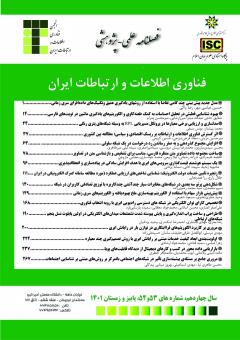شکلدهی پرتو سه بعدی در شبکههای مخابرات سیار چندآنتنی چند کاربره با توزیع تصادفی کاربران در شبکه
محورهای موضوعی : فناوری اطلاعات و ارتباطاتسید محمد رضوی زاده 1 , نسیم محمدی 2
1 - دانشگاه علم و صنعت ایران
2 - دانشگاه علم و صنعت ایران
کلید واژه: شکلدهی پرتو سه بعدی, فرآیند نقطهای پواسون, شبکهی چندورودی-چند خروجی چند کاربره, احتمال پوشش,
چکیده مقاله :
در این مقاله به مساله استفاده از روش شکل دهی پرتو سه بعدی(3DBF) در یک شبکه مخابرات سلولی چند ورودی-چند خروجی (MIMO) پرداخته شده است. شبکه مورد نظر از یک سلول با چندین کاربر تشکیل شده است و در آن کاربران براساس فرآیند نقطهای پواسون (PPP) در سطح سلول توزیع شدهاند که به شرایط موجود در یک شبکه واقعی مخابرات سیار نزدیک تر میباشد. در این حالت تعداد کاربران درون سلول و موقعیت آنها تصادفی خواهد بود. با توجه به توزیع کاربران در محیط و تفاوت فاصلهی آنها از ایستگاه پایه، زوایای عمود (زاویه تیلت) آنها نیز متفاوت خواهد بود. با در نظر گرفتن ارسال فروسو و پیشکدکنندهی اعمال صفر (ZF) در فرستنده ایستگاه پایه با هدف حذف تداخل بین کاربران درون سلول، به بررسی و تحلیل احتمال پوشش در سلول پرداخته و سپس بهترین زاویهی عمودی آنتن را برای دستیابی به بیشترین احتمال پوشش را به دست میآوریم. با استفاده از آنالیز نتایج عددی حاصل از روابط به دست آمده، دقت محاسبات و مقدار زاویهی عمود بهینه آرایه آنتن مورد بررسی و تایید قرار میگیرد
In this paper, problem of using the 3D beamforming method (3DBF) in a multi-input-multi-output cellular communication network (MIMO) is discussed. The network consists of a cell with multiple users, in which users are distributed based on the Poisson point (PPP) process at the cell area, which is closer to the conditions in a real mobile network. In this case, the number of users inside the cell and their location will be random. Depending on the distribution of users in the space and the difference in their distance from the base station, their elevation angles will also be different. Considering the downlink transmission and the zero-forcing (ZF) precoder in the base station, with the aim of eliminating intra cell interference, we evaluate and analyze the probability of coverage in the cell and then we obtain the best antenna tilt angle to achieve maximum probability of coverage. Using the analysis of numerical results, the accuracy of the calculations and the value of the optimal tilt angle of the antenna array are confirmed.
F. Al-Turjman, E. Ever, and H. Zahmatkesh, “Small cells in the forthcoming 5G/IoT: Traf_c modelling and deployment overview,” IEEE Commun. Surv. Tuts., vol. 21, no. 1, pp. 28_65, 1st Quart., 2019.
J. Ye, X. Ge, G. Mao, and Y. Zhong, “5G ultradense networks with nonuniform distributed users,” IEEE Trans. Veh. Technol., vol. 67, no. 3, pp. 2660–2670, March 2018.
C. Chen and X. Zhao, “Cell boundary user performance in multi-user MIMO poisson oronoi cell,” IEEE Commun. Lett., vol. 22, no. 4, pp. 772 – 775, 2018.
X. Zou, G. Cui, M. Tang, and W. Wang, “Base station density bounded by maximum outage probability in massive MIMO system,” in Proc. IEEE VTC, May 2015, pp. 1–5.
Q. H. Spencer, C. B. Peel, A. L. Swindlehurst and M. Haardt, “An introduction to the multi-user MIMO downlink,” IEEE Commun. Magazine, vol. 42, pp: 60-67, Oct. 2004.
S. Kusaladharma, W.-P. Zhu and W. Ajib, “Exact outage analysis for stochastic cellular networks under multi-user MIMO,” IEEE 17th Annual Consumer Communications & Networking Conference (CCNC), Jan. 2020.
A. Kuchar, J.-P. Rossi, and E. Bonek, “Directional macro-cell channel characterization from urban measurements,” IEEE Transactions on Antennas and Propagation, vol. 48, no. 2, pp. 137–146, Feb. 2000.
Q-A Nadeem, A. Kammoun and M-S Alouini, “Elevation beamforming with full dimension mimo architectures in 5G systems: a tutorial,” IEEE Communications Surveys & Tutorials, vol. 21, 2019.
S. M. Razavizadeh, M. Ahn and I. Lee, “three-dimensional beamforming: a new enabling technology for 5G wireless networks,” IEEE Signal Processing Magazine, vol. 31, 2014.
W. Lee, S-R. Lee, H-B. Kong, S. Lee and I. Lee, “Downlink vertical beamforming design for active antenna systems,” IEEE Transactions on Communications, vol. 62, 2014.
M. Baianifar, S. M. Razavizadeh, S. K-Moghaddam and T. Svensson, “Effect of users height distribution on the coverage of mmwave cellular networks with 3D beamforming,” IEEE Access, vol. 7, pp: 68091 – 68105, May 2019.
S. Atapattu, P. Dharmawansa, C. Tellambura and J. Evans, “Exact outage analysis of multiple-user downlink with MIMO matched-filter precoding,” IEEE Commun. Lett., vol. 21, no. 12, pp: 2754-2757, Dec. 2017.
Ch. Li, J. Zhang and K. B. Letaief, “Performance analysis of SDMA in multicell wireless networks,” IEEE Global Communications Conference (GLOBECOM), Dec. 2013.
Zh. Shi, G. Yang, Y. Fu, H. Wang and Sh. Ma, “ Performance analysis of MIMO-NOMA systems with randomly deployed users,” IEEE Global Communications Conference (GLOBECOM), Dec. 2018.
X. Yu, Ch. Li, J. Zhang and K. B. Letaief, stochastic geometry analysis of multi-antenna wireless networks, Springer, 1st ed. 2019.
S. M. Razavizadeh and T. Svensson, “3D beamforming in reconfigurable intelligent surfaces-assisted wireless communication networks,” 24th International ITG Workshop on Smart Antennas (WSA), Feb. 2020.
Zh. Chen, L. Qiu and X. Liang, “Area spectral efficiency analysis and energy consumption minimization in multi-antenna poisson distributed networks,” IEEE Trans. Wireless Commun., vol. 15, pp: 4862-4874, 2016.
M. Joham, W. Utschick and J. A. Nossek, “linear transmit processing in MIMO communications systems,” IEEE Trans. Signal Process., vol. 53, no. 8, pp: 2700-2712, Aug. 2005.


